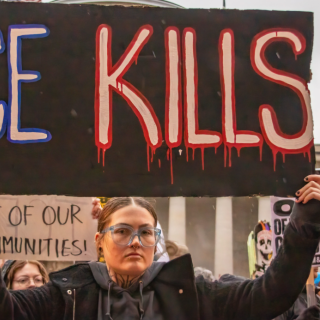Advertisement
Every day in the U.S., women fight to break the glass ceiling and rise to the top of companies and industries that were predominantly held by men. Forbes magazine published the Power Women 2018 edition showcasing women from around the globe who are changing the look of the future for young women and girls. Taking a look at these forerunners can inspire true feelings of inspiration.
Whether they are joining the Women’s March to leverage the political power of diverse women in their communities to fight for social change or are running a small business, women everywhere are advancing themselves into power positions. Sometimes, this includes heading into jobs that men are leaving, such as animal agriculture in the American West.
Women aren’t just marching to have a voice; they are voting and serving too. Female lawmakers made history when over 100 women won Congressional seats in the 2018 election. These women follow in the footsteps of other females in politics like Supreme Court Justice Ruth Bader Ginsburg, who told USA Today that women of her vintage had not just one story, but many stories that align with the powerful #MeToo movement. She went on to say that in her time women felt there was nothing they could do about sexual harassment and chalked it up to “boys being boys.”
Modern women continue to shape feminism and make strides in all areas of society, including leadership and combat. Women are redefining images of marriage and gender roles in homes and leaning on social media for a unified voice.
New Roles for Women in Art and LoveWhat does it mean to be a female leader in 2019? It’s critical to understand that being a leader has nothing to do with a title. You can be a leader in all walks of life, income levels, and industries. You can even be a leader as a volunteer or in your group of friends or family. Leadership for the women of the world can bridge the divides between female CEOs, women working on farms, and women hustling every day as artists.
Women are redefining what it looks like to be female. There are taking on roles that were historically thought of to be “male,” such as photographers, and changing the idea of what women should look like on both sides of the lens. Modern marriages don’t always have a man and woman standing at the altar. As gender roles shift, the notion of what a woman can or should do in their lifetime must change too.
Embracing the diverse beauty of today’s woman is pivotal for the future. An ideal wedding photo might look different for those in the LGBTQIA community but is no less beautiful. Even weddings of a heterosexual couple can look entirely different than those that happened just a few decades ago. Young women now propose to their partners and plan weddings together in locations other than churches. Whether you are a gay couple searching for marriage equality in a conservative state like Ohio or a young woman planning a feminist wedding, it’s critical that the voices of all women be heard.
Changing the Face of the MilitaryWomen in the military aren’t new. In fact, women serving their country dates back to the American Revolution, when they served as nurses and cooks to support the troops. Over the years, the roles have changed for women in the military. By World War II females had more choices about how to serve their country. While many continued to serve in traditional roles, diversity opened allowing them to work as drivers, pilots, and mechanics.
Women’s roles in the military led to the passage of the Women’s Armed Services Integration Act by President Harry Truman. This act paved the way for women to be recognized as full members of the armed forces and claim benefits. Women continue to progress and break into new military roles. In 2015, two women completed the prestigious Army Ranger School, leading to the Pentagon issuing a decree that all combat jobs be open to women.
Living and working in an environment that continues to be male-dominated isn’t always easy. Some females suffer at the hands of other soldiers. The term “military sexual trauma” refers to any sexual assault or harassment that happens while in the military. However, the trauma doesn’t stop with the sexual act. Some women have suffered emotional injury in how the Department of Defense handles these situations.
It’s easy to think that acts such as sexual trauma happen in other places. However, these acts have occured to women who call Ohio home, and might have you asking, “Is this how we treat women in the military?” Women train for the battlefield beside their male counterparts. They are a part of the strategic solution to our increasingly stressed global environment, and they are refusing to remain silent in the face of inequalities. We must remember that even though sexism is alive and well in the military, advancements in social justice are not achieved when women are not at the table.
Embracing #MeTooThree out of every four sexual assaults go unreported, making it the most underreported crime in the United States. Victims don’t report due to the fear of retaliation, believing that the police won’t help or feeling that it was simply a personal matter. Raising awareness of the issue through the #MeToo movement on social media has brought justice to victims.
You might think that #MeToo began with allegations against powerful men in politics and entertainment. However, the phrase was coined by Tarana Burke almost 10 years earlier to help women of color who had survived sexual assault. The movement has been tagged in everything from the Harvey Weinstein and R. Kelly allegations to a Cleveland radio station’s ban on “Baby, It’s Cold Outside.” It’s also helped increase enrollment in sexual assault nurse examiner programs around the country, making the #MeToo movement and forensic nurses allies in the fight against sexual crimes on women.
According to the U.S. Equal Employment Opportunity Commission, 28,000 harassment claims were filed in 2015. Of this number, 45 percent were sex-based claims, which include gender identity, sexual orientation, and sexual harassment claims, reminding us that the #MeToo movement isn’t just for Hollywood.
Farmworker women called upon the popular restaurant chain Wendy’s to stop supporting sexual violence in Mexican agriculture. Female farmworkers in this region reported enduring the pressure to exchange sex and accept sexual advances from supervisors for daily work. While sexual harassment isn’t new, the way women are addressing advancements with a fervor like never before is new.
Year of the WomanThe strength of women today is insurmountable. From farmland to Fortune 500 companies, women are rising to the top in leadership and media. The future looks bright for the women of today and the female leadership of tomorrow.



